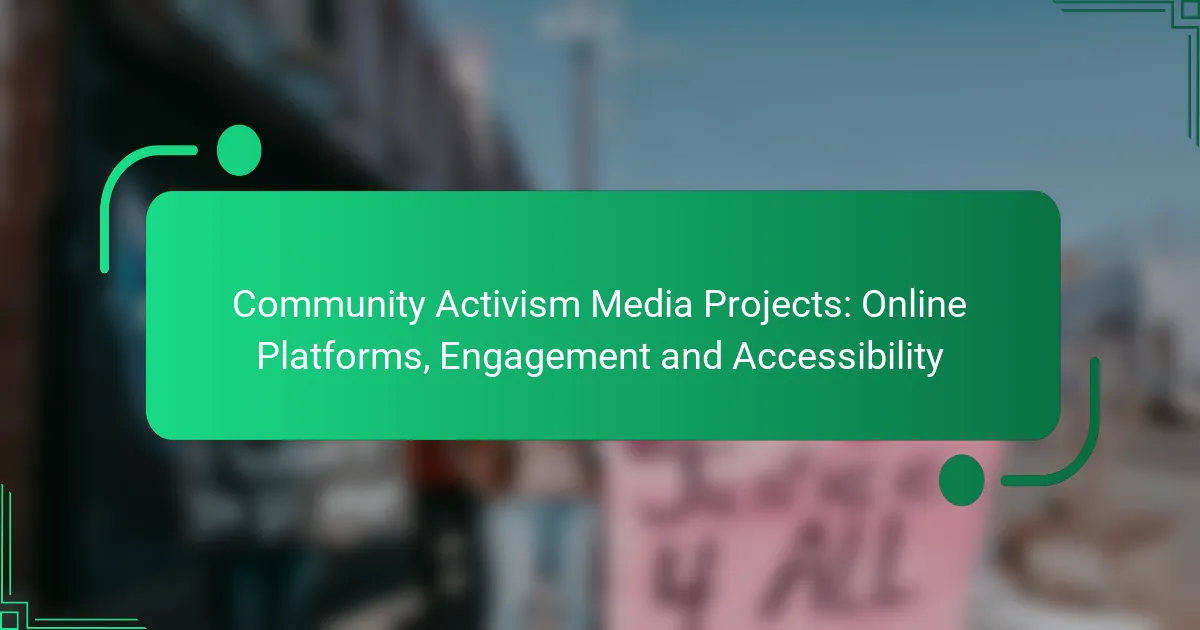Community activism in New York is increasingly empowered by online platforms that enhance communication, fundraising, and collaboration among activists. By utilizing effective engagement techniques, these platforms create meaningful connections and amplify diverse voices, ensuring that activism resonates with a wider audience. Additionally, incorporating accessibility features is essential for fostering inclusive participation, allowing individuals of all abilities to engage fully in the movement.
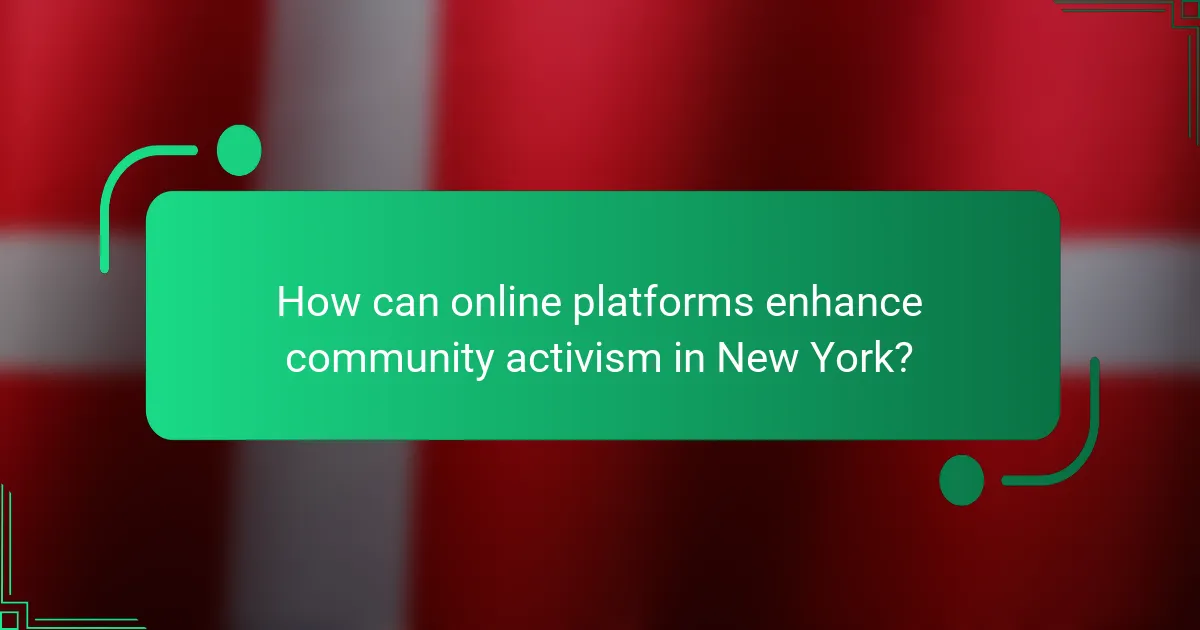
How can online platforms enhance community activism in New York?
Online platforms can significantly boost community activism in New York by facilitating communication, fundraising, and collaboration among activists. These tools help mobilize support, share information, and engage a broader audience effectively.
Social media engagement strategies
Social media platforms like Facebook, Twitter, and Instagram are essential for community activism in New York. They allow activists to share updates, organize events, and rally support quickly. Utilizing hashtags and engaging content can increase visibility and encourage participation.
Consider creating a content calendar to maintain consistent posting and interaction. Engaging with followers through polls, live videos, and Q&A sessions can foster a sense of community and encourage more active involvement.
Online fundraising tools
Online fundraising platforms such as GoFundMe, Kickstarter, and Patreon can help community activists in New York raise necessary funds for their initiatives. These tools provide a straightforward way to reach potential donors and share compelling stories that resonate with the audience.
When using these platforms, ensure to set clear fundraising goals and provide regular updates to donors. Transparency about how funds will be used can build trust and encourage more contributions.
Community forums for discussion
Community forums like Reddit, Nextdoor, or specialized platforms can serve as vital spaces for discussion among activists in New York. These forums allow individuals to share ideas, seek advice, and collaborate on projects, fostering a sense of belonging and shared purpose.
To maximize engagement, create dedicated threads for specific topics or events. Encourage respectful dialogue and ensure that moderators are present to facilitate discussions and maintain a positive environment.
Event promotion via platforms
Promoting events through online platforms is crucial for attracting participants to community activism activities in New York. Websites like Eventbrite and Meetup can help organize and publicize events, making it easy for interested individuals to RSVP and share with their networks.
Utilize social media to amplify event promotion by creating event pages and sharing engaging visuals. Consider using targeted ads to reach specific demographics that align with your cause, increasing the likelihood of participation.
Collaboration with local influencers
Partnering with local influencers can enhance community activism efforts in New York by leveraging their reach and credibility. Influencers can help spread awareness about initiatives and events, attracting a wider audience and encouraging engagement.
When collaborating, choose influencers whose values align with your cause. Develop clear agreements on how they will promote your activities, and provide them with the necessary information and materials to effectively communicate your message.
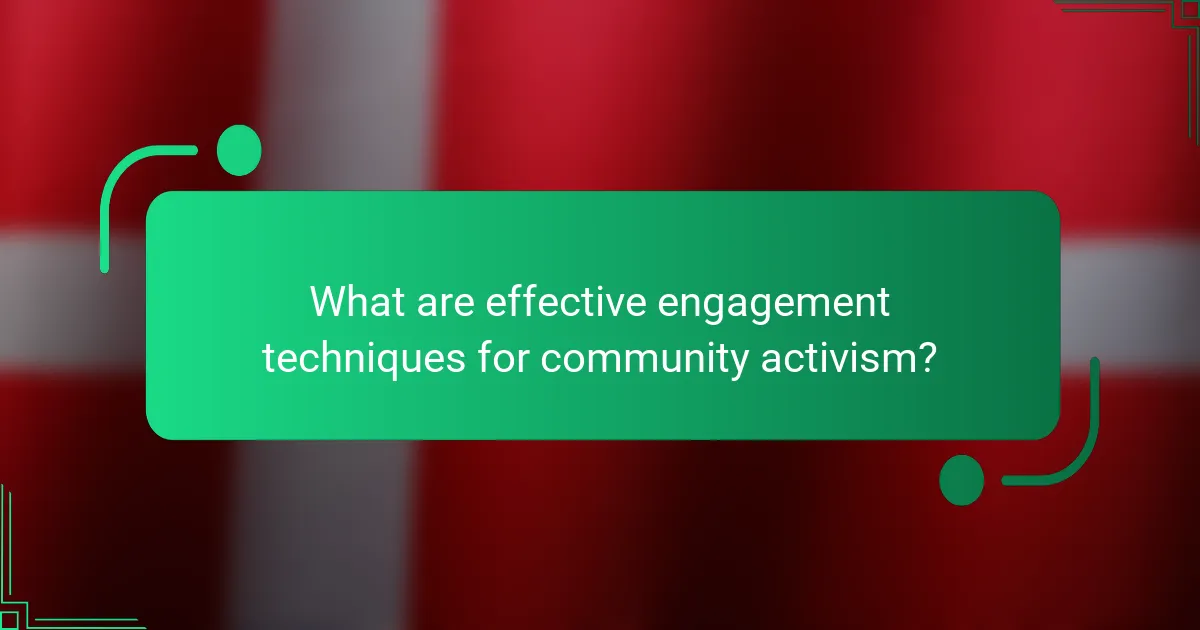
What are effective engagement techniques for community activism?
Effective engagement techniques for community activism involve creating meaningful connections with the community through various interactive and accessible methods. These techniques foster participation and amplify voices, ensuring that activism resonates with a broader audience.
Storytelling through multimedia
Storytelling using multimedia formats, such as videos, podcasts, and infographics, can significantly enhance community activism. These tools allow activists to share personal narratives and experiences, making complex issues more relatable and engaging.
Consider using platforms like YouTube or Instagram to showcase stories visually. Aim for short, impactful content that captures attention quickly, ideally under three minutes for videos or concise audio segments for podcasts.
Interactive webinars and workshops
Interactive webinars and workshops provide a platform for real-time engagement and knowledge sharing among community members. These sessions can cover various topics, from advocacy strategies to skill-building exercises, fostering a sense of community and collaboration.
To maximize participation, schedule events at convenient times and promote them through social media and local networks. Use tools like Zoom or Google Meet, and keep sessions under two hours to maintain focus and energy.
Utilizing local news outlets
Engaging local news outlets can amplify the reach of community activism initiatives. By collaborating with journalists or submitting press releases, activists can inform the public about events, issues, and successes, thereby increasing visibility and support.
Focus on building relationships with local reporters and editors. Provide them with compelling stories and data that highlight community needs. Regular updates can help maintain interest and encourage ongoing coverage of activism efforts.

What accessibility features should online activism platforms include?
Online activism platforms should incorporate accessibility features that enhance user experience for all individuals, including those with disabilities. Key features include screen reader compatibility, multilingual support options, and mobile-friendly design to ensure broad engagement and participation.
Screen reader compatibility
Screen reader compatibility is essential for users with visual impairments. Platforms should ensure that all text, images, and interactive elements are properly tagged and described, allowing screen readers to convey the information accurately. Regular testing with popular screen readers can help identify and resolve compatibility issues.
To enhance usability, consider using semantic HTML elements, such as headings and lists, which provide structure and context for screen readers. Avoid using images of text, as these cannot be read aloud effectively.
Multilingual support options
Multilingual support options enable platforms to reach a diverse audience by providing content in multiple languages. This can be achieved through translation features or by offering content in various languages from the start. It’s important to ensure that translations are accurate and culturally relevant.
Consider implementing language selection tools prominently on the site, allowing users to switch languages easily. Additionally, providing language-specific resources can enhance engagement and accessibility for non-native speakers.
Mobile-friendly design
Mobile-friendly design is crucial as many users access online platforms via smartphones and tablets. A responsive design ensures that content is easily readable and navigable on smaller screens. Key aspects include optimizing images, using larger touch targets, and maintaining a simple layout.
Test the platform across various devices and screen sizes to ensure a seamless experience. Avoid excessive pop-ups and complex navigation menus that can frustrate mobile users. Prioritize fast loading times, as delays can significantly impact user engagement.
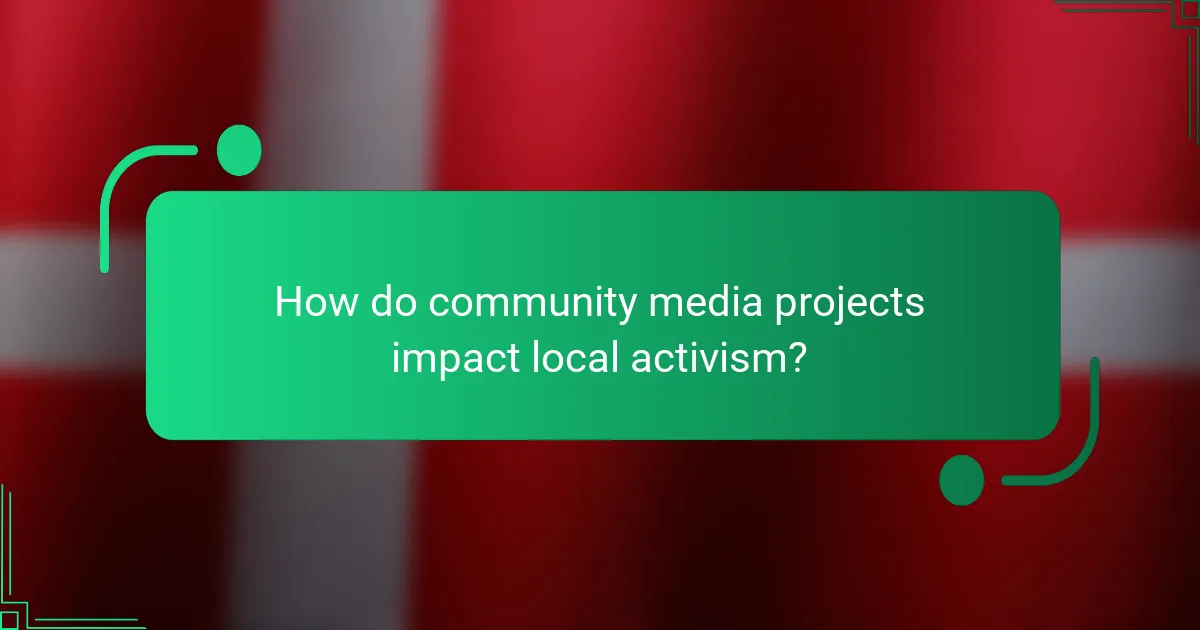
How do community media projects impact local activism?
Community media projects significantly enhance local activism by providing platforms for awareness, engagement, and mobilization around local issues. They create opportunities for residents to share their experiences and advocate for change, fostering a more informed and active community.
Increased visibility for local issues
Community media projects elevate the visibility of local issues by disseminating information through various channels such as social media, blogs, and podcasts. This increased exposure helps draw attention to problems that may otherwise go unnoticed, encouraging public discourse and action.
For example, a community radio station might highlight environmental concerns affecting a neighborhood, prompting local government to address these issues. By amplifying these topics, community media can influence public opinion and policy decisions.
Empowerment of marginalized voices
These projects empower marginalized voices by providing a platform for individuals who are often overlooked in mainstream media. Community media allows these groups to share their narratives, fostering a sense of ownership and agency in the activism process.
For instance, a local video project might feature stories from immigrant communities, showcasing their challenges and contributions. This representation can lead to greater understanding and support from the broader community, ultimately driving positive change.
Creation of local networks
Community media projects facilitate the creation of local networks by connecting individuals and organizations with shared interests and goals. These networks can enhance collaboration and resource sharing, making activism more effective and coordinated.
Local workshops or online forums can serve as hubs for activists to exchange ideas, strategies, and support. By building these connections, community media strengthens the overall capacity for local activism, enabling more impactful initiatives.
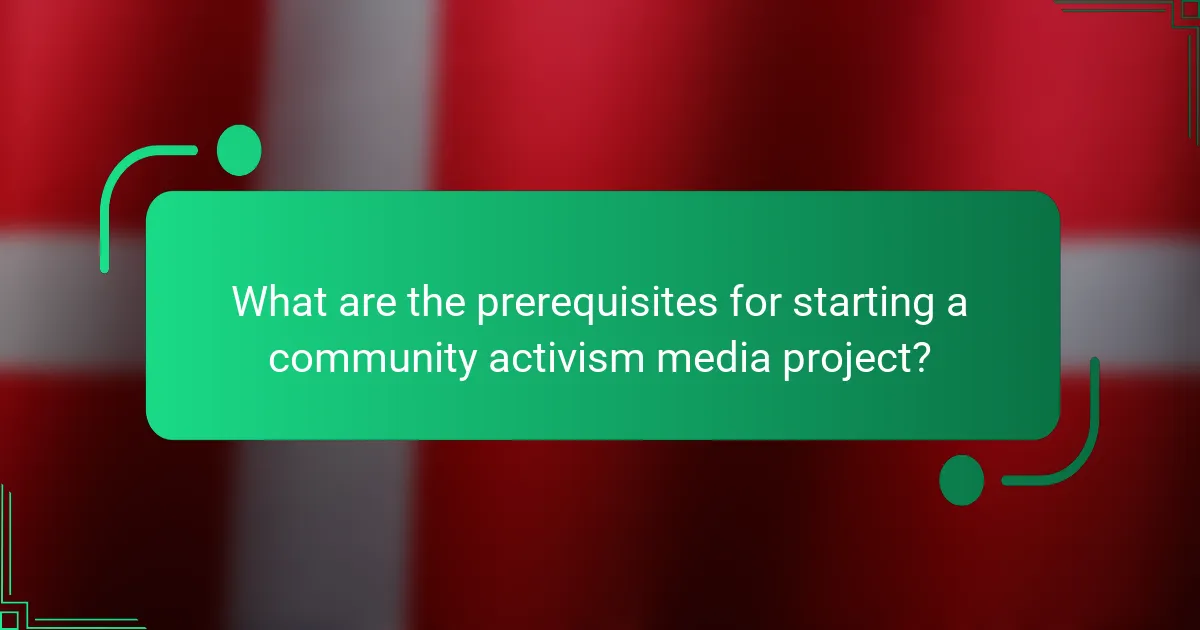
What are the prerequisites for starting a community activism media project?
Starting a community activism media project requires a clear understanding of your goals, target audience, and the resources available to you. Essential prerequisites include establishing a mission, assembling a dedicated team, and ensuring access to the necessary technology and platforms for effective outreach.
Understanding your community’s needs
Identifying the specific needs of your community is crucial for a successful activism media project. Conduct surveys, hold focus groups, or engage in discussions to gather insights about the issues that matter most to your audience. This foundational knowledge will guide your content and engagement strategies.
Building a dedicated team
A committed team is vital for the sustainability of your project. Recruit individuals with diverse skills, including content creation, social media management, and community outreach. Ensure that team members share a common vision and are passionate about the cause, as this will enhance collaboration and motivation.
Accessing technology and platforms
Effective community activism relies on the right technology and platforms for communication and engagement. Familiarize yourself with various social media channels, content management systems, and video conferencing tools. Choose platforms that align with your audience’s preferences and ensure they are accessible to all community members.
Establishing a clear mission
A well-defined mission statement serves as the backbone of your project. It should articulate your goals, the issues you aim to address, and the impact you hope to achieve. This clarity will not only guide your activities but also attract supporters and collaborators who resonate with your vision.
Creating a budget
Developing a realistic budget is essential for managing resources effectively. Consider costs associated with technology, marketing, and team compensation. Seek funding through grants, donations, or crowdfunding to support your initiatives, and regularly review your budget to ensure financial sustainability.
